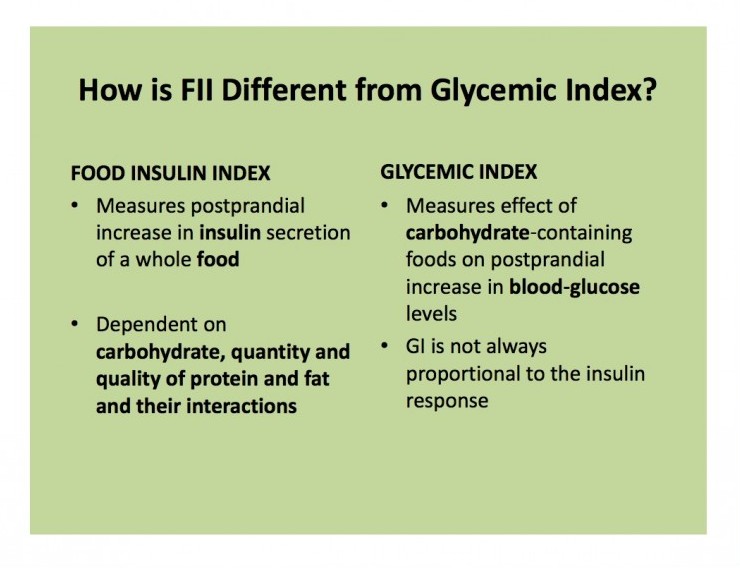Who isn’t looking to drop a few pounds? We all want to be leaner and look better in our clothes. There’s good news – the insulin index is a great tool to help you achieve your ideal weight. Learn how it differs from the glycemic index, and how to use it to your advantage.

Wikipedia states: The Insulin Index of food represents how much it elevates the concentration of insulin in the blood during the two-hour period after food is ingested. The insulin index – or food insulin index (FII) – can help with weight loss because knowing the potential impact of any given food on insulin levels will allow you to choose foods that do not spike insulin. These spikes lead to weight gain and metabolic chaos.
Table of Contents
How The Insulin Index Differs From The Glycemic Index
The glycemic index is associated with blood sugar levels, and the impact food has on blood-sugar rise. For instance, ice cream and candy are high on the glycemic index due to the rise in blood sugar they cause, whereas, low-starch vegetables would be low on the glycemic index because they cause a negligible rise in blood sugar.
The FII may be more effective as a weight-loss tool than the glycemic index (GI) because it measures insulin release, which is the fundamental problem in obesity, insulin resistance, and diabetes -with all the complications associated with these two conditions. For instance, a meal that is low glycemic may still require a lot of insulin, but may not cause a significant rise in blood glucose because it digests more slowly, in part due to the fiber content. An example of this would be low fat-dairy products.
Low-fat flavored yogurt rates 21 on the GI, but 84 on the FII. Low-fat foods are typically sweetened with artificial sweeteners, which are not taken into account in the GI, but are very relevant in the FII because they do, in fact, stimulate insulin. The FII also takes into account protein and fiber. Quantity and quality are both important.
Another difference between the GI and FII pertains to foods containing a lot of fructose. These foods may not cause blood-sugar spikes, but they do cause rises in insulin. This is why foods that were previously considered safe for people with diabetes, may not be ideal after all.
Disclaimer: This post contains affiliate links
The FII Is More Comprehensive
The FII is more comprehensive as a guide to blood-sugar levels than the GI. While the GI can help decrease diabetic markers, such as the A1C, by focusing on low-glycemic carbs, it doesn’t factor in the other macronutrients protein and fat. The food insulin index takes into account other foods than just carbohydrates – like protein for example, which does raise insulin levels. Fat is a neutral macro nutrient, meaning it does not stimulate insulin.
The reason the FII is so relevant regarding weight loss is that you cannot burn fat in the presence of insulin. Not only do elevated insulin levels lead to weight gain, these elevated levels also prevent weight loss. Think of it as your fat being held hostage. Not a pleasant visual I know.
High-insulin levels will also promote cravings after meals so it’s basically three strikes you’re out on the fat-loss front until these levels come down. That’s how human biochemistry works. This explains why fat, although higher in calories, ranks low on the FII as it has a negligible effect on insulin. This is why people lose weight on high-fat eating plans such as the Atkins or Ketogenic Diet.

Chart taken from Beyond Glycemic Index: New Food Insulin Index
by Kent, Franz, Millet and Willet
As you can see the FII may be a more relevant tool, than the GI, for those trying to lose weight because it measures the postprandial (after-meal effect) insulin release of a whole food.
It also takes into account the macronutrients that are consumed at the meal. The GI, however, only measures the effect of the carbohydrate on postprandial blood-sugar levels. It is not always proportional to the FII.
How Meal Timing Affects Insulin Levels
Sticking to just two or three meals a day is another great way to lower insulin levels, and stimulate the fat-burning hormones glucagon and human growth hormone. Utilizing intermittent fasting is another great tool for this.
If you need to snack between meals, then go for the fat, as it will allow you to continue to burn your body fat for fuel as no insulin release is required. Remember that insulin shuts down fat burning.
The ultimate goal is to burn what you eat and then use your body fat for fuel between meals. Low-insulin levels, between meals, allow you to tap into your energy stores. This is called balancing the oxidative rate.
Further comparison of the FII and GI
People who are dieting typically try to consume foods low on the GI. This is a helpful strategy. However, a better model may be to eat foods that are also low on the FII. These tools can be used in conjunction with each other.
We all remember when the low-fat movement became popular, and many people gained weight due to the impact of these foods on hormones. Even though fat has twice the calories of protein and carbohydrate, it allows insulin levels to remain low, which is far more conducive to fat loss.
The GI is based more on a calorie model while the FII is based on the hormonal response a particular food evokes. Hormones control metabolism, and we can tell our hormones what to do based on diet and lifestyle factors.
So, in essence, we have control over metabolism. Fat is such an important macro nutrient as it is needed for essential fatty acids, production of hormones, cell-membrane integrity, brain function, and improved body composition.
However, fat does not contain the necessary micronutrients needed for healthy physiology so it needs to be balanced by consuming a liberal amount of non-starchy vegetables that are high in the essential micro-nutrients. The fiber from these foods is also important for optimal intestinal health, and increased satiety.
[Read More: Interval Training Workouts For Weight Loss]
Benefits Of Balanced Insulin Levels
- Increased energy
- Increased fat loss
- Reduced cravings
- Reduced glucose levels
- Decreased triglycerides and cholesterol
- Diabetes prevention
- Decreased inflammation
- Decreased blood pressure
- Increased longevity
- Better brain function
It’s easy to test your blood sugar levels yourself from home, and is a highly effective way to measure how the carbohydrates you consume at each meal are impacting your glucose levels. You can get your fasting insulin testing through direct-to-consumer online lab testing. Fasting insulin should be under 5, but ideally below 3.
Access A1C testing here
Get your fasting insulin tested here
Key Points
Can you see the importance of eating according to the insulin index? Identifying foods that require a lowered insulin response will lead to weight loss. This is why you want to keep insulin, which is an anabolic (building) hormone, low.

If weight loss is your goal, try focusing on lowering your insulin levels through your dietary and lifestyle habits. There are many other benefits of decreased insulin, as well, such as decreased inflammation, lower blood pressure, and diabetes prevention.
Since insulin is intricately connected to hormones, lowering it will lead to better hormonal balance. The FII is more effective for weight loss than just counting carbs because it accounts for the hormonal response generated from foods.
Are your insulin levels higher than they should be? How can you tell? Let me know in the comments:)
References:
(1) Glycemic Index Foundation: What Is The Food Insulin Index
(2) US National Library of Medicine – National Institutes of Health: Dietary insulin load and insulin index are associated with the risk of insulin resistance: a prospective approach in tehran lipid and glucose study
(3) US National Library of Medicine – National Institutes of Health: Dietary insulin load, dietary insulin index, and colorectal cancer
(4) National Center for Biotechnology Information: Food Insulin Index: Physiologic Basis for Predicting Insulin Demand Evoked by Composite Meals
(5) National Center for Biotechnology Information: Does Food Insulin Index in the Context of Mixed Meals Affect Postprandial Metabolic Responses and Appetite in Obese Adolescents With Insulin Resistance? A Randomised Cross-Over Trial
(6) Pritikin Longevity Center: Glycemic Index: New Study Finds Popular Weight Loss Tool Worthless
(7) healthline: A Beginner’s Guide to the Low Glycemic Diet
(8) Harvard Health Publishing / Harvard Medical School: The lowdown on glycemic index and glycemic load
Disclaimer: This article is strictly for informational purposes only and is not intended to be medical advice.


great post. you may be interested in the list of low insulin load foods here. https://optimisingnutrition.com/2015/03/23/most-ketogenic-diet-foods/
Thanks for reading Marty and for the link. I am very interested in the low insulin load foods list! Very much appreciated!!!
My sister has tried every diet there is and has had varying degrees of success. She’s been struggling with her weight since she was a kid. Even when she was able to lose weight, she would gain it all back and than some.
I think that the Insulin Index is something she’d be interested in. I went ahead and sent her a link. Thanks for explaining everything there is to know about this tool. I’m sure it will help a lot of people lose weight. I also saved your websites to my favorites for future reference.
Jack
Hi Jack,
The hormonal component is commonly not taken into account when people are trying to lose weight. That’s likely why your sister always gains the weight back she has lost. Unfortunately, in this yo-yo dieting scenario, dieters usually pack on more pounds afterwards. It’s sad and I feel for your sister.
The Insulin Index is a great tool because it takes into account the hormone insulin and how the carbohydrates in a meal impact it. Insulin is an anabolic hormone, meaning it’s a building hormone. Not only does it cause people to gain weight, it prevents them from losing it.
On top of all that, people get cravings when their insulin levels are high, which makes it extremely difficult to lose weight. Thanks for sending your sister my article!